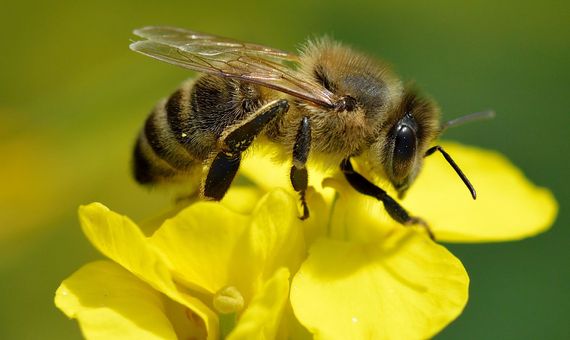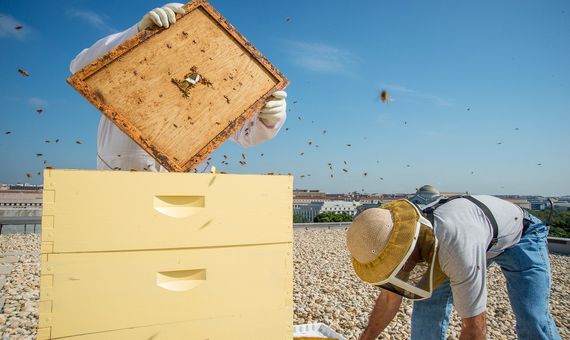It is traditional in any reference to the environmental threats to our planet to quote the physicist Albert Einstein when he said that if the bee disappeared from the surface of the globe, humanity would have only four years of life left, as food crops would have no one to pollinate them. The truth is that, as is so often the case, it does not appear that Einstein ever said such a thing. And while the alleged four-year time frame cannot be attributed to any other scientific source either, at least the fake quote serves as a reminder of the important role of bees in the context of a worrying reality: the decline of bee populations led in 2007 to the coining of a new term, Colony Collapse Disorder (CCD), whose causes and solutions are still being investigated.
Nearly nine out of ten flowering plants depend on various animals for pollination. Among them, the western (or European) honey bee (Apis mellifera), the most common species of honey bee and spread worldwide through beekeeping, is the most frequent floral visitor in nature. It is often said that bees are responsible for the pollination of one third of our crops, such as fruit trees, berries, vegetables and even alfalfa, but not others such as maize, tubers and root vegetables (e.g. potatoes and carrots) or leafy vegetables. In nature, around 5% of plant species are critically dependent on these creatures, while almost half of all plants are ignored by bees.
The causes of the disappearance of such an intelligent species
But while the role of bees in the survival of humankind has perhaps been over-dramatised, their importance in nature is indisputable, as is their contribution to the economy through the services beekeeping provides to ecosystems. As if that were not enough, bees are the subject of scientific studies that have discovered astonishing capacities in a brain of half a millimetre with less than a million neurons: they recognise human faces, encode spatio-temporal data in their dance and handle mathematical concepts, such as the ordering of quantities, addition, subtraction and even the idea of the number zero.

Crises in beekeeping operations have been sporadic in the history of beekeeping, but in the late 20th century a steady decline began to be detected in several countries. In 2007, a flurry of reports from North America, according to which some beekeepers had lost between 30% and 90% of their hives, led to the definition of CCD, for which multiple possible causes were suggested: neonicotinoid or neonic insecticides, pests such as the parasitic mite Varroa destructor, the fungus Nosema ceranae and bacterial or viral infections, environmental stress, malnutrition, low genetic diversity, habitat destruction or the effects of climate change, among others.
However, the relative contribution of these possible causes is still under study. Infections may be relevant; the permanent nature of hives—unlike, for example, wasps, which die in autumn and the queen founds a new colony the following year—makes them fertile ground for infections. As for the controversial neonics, although they are toxic to insects, including bees, there is no consensus on their actual impact on CCD. In Australia, widespread adoption of these insecticides did not result in an increased incidence of CCD, and only in cases where these or other pesticides were used incorrectly were hives affected. Some of these compounds have been banned in the EU and other countries.
Can we save the bees?
In fact, according to experts, the causes of CCD can be diverse in different regions, and even vary over time. Moreover, some experts believe that under the umbrella term CCD, defined in the US with specific symptoms—the disappearance of adult bees without corpses in well-stocked storage hives—cases from other continents with different symptoms are being included. Although declines in natural bee populations, as with all insects in general, have been detected worldwide, this phenomenon is not necessarily linked to CCD. And while CCD has affected farms in the US, Western Europe and parts of Asia, globally beekeeping has increased by 45% in the last five decades. According to the US Environmental Protection Agency, reports of CCD cases in the US have declined substantially over the past five years, which has led many experts to question whether there is a sustained trend.

In view of the above, and because it is a problem with no clear single cause but likely produced by a combination of factors, and which seems to wax and wane for no apparent reason, there is also no one-size-fits-all solution. Apart from precautionary measures concerning the restriction of neonics, or more basic breeding measures such as isolating diseased colonies, researchers continue to collect data, and large projects are being undertaken to improve breeding programmes and hive health monitoring, as well as searching for new drugs against infections or antidotes against the effects of pesticides. Fortunately, it seems that the bee apocalypse predicted a few years ago has not yet arrived, but the stinger is still in.
Comments on this publication